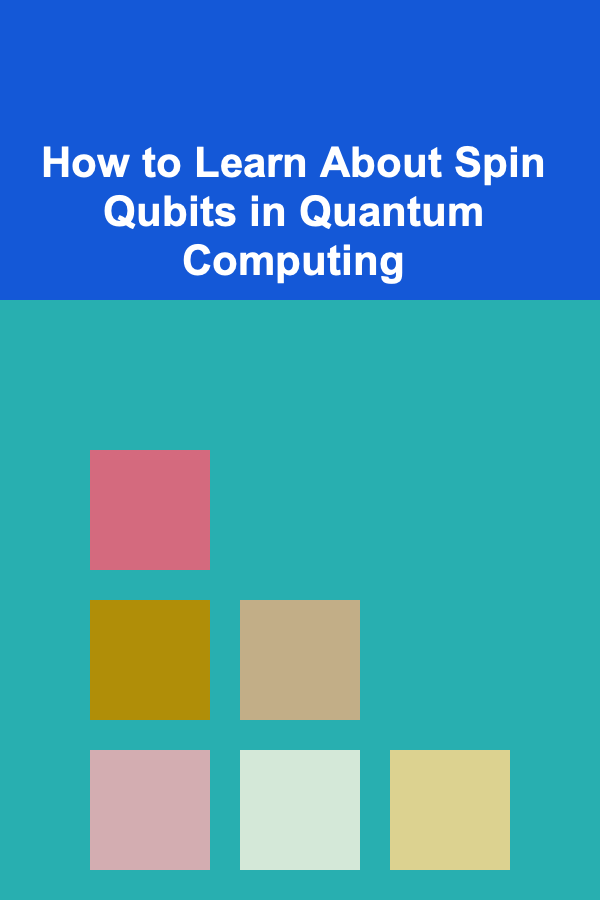
How to Learn About Spin Qubits in Quantum Computing
ebook include PDF & Audio bundle (Micro Guide)
$12.99$9.99
Limited Time Offer! Order within the next:

Quantum computing, a field poised to revolutionize computation, leverages the principles of quantum mechanics to solve problems that are intractable for classical computers. Within this field, various physical systems are being explored as potential qubits, the fundamental units of quantum information. Among these, spin qubits have emerged as a promising candidate due to their potential for scalability, coherence, and compatibility with existing semiconductor technology. This article provides a comprehensive guide on how to learn about spin qubits in quantum computing, covering the necessary background knowledge, relevant resources, learning pathways, and emerging trends.
I. Foundational Knowledge: Building the Necessary Base
Before diving into the specifics of spin qubits, it is essential to establish a solid foundation in the core concepts of quantum mechanics, condensed matter physics, and semiconductor physics. This foundational knowledge will provide the necessary framework for understanding the underlying principles that govern spin qubit behavior and control.
A. Quantum Mechanics: The Rules of the Quantum World
Quantum mechanics is the cornerstone of quantum computing. A thorough understanding of its principles is paramount. Here's a breakdown of key concepts:
- Quantum States and Superposition: Grasp the concept of qubits existing in a superposition of states (0 and 1 simultaneously) and how this differs from classical bits. Understand the mathematical representation of quantum states using Dirac notation (ket notation) and the concept of probability amplitudes.
- Entanglement: Explore the phenomenon of entanglement, where two or more qubits become correlated in such a way that the state of one qubit instantaneously influences the state of the others, regardless of the distance separating them. Understand its role in quantum algorithms and quantum communication.
- Quantum Measurement: Learn how measurement collapses the superposition state of a qubit into a definite classical state (0 or 1). Understand the probabilistic nature of quantum measurement and the concept of measurement operators.
- Quantum Operators and Unitary Transformations: Understand how quantum operations are represented by unitary operators that transform the state of a qubit. Familiarize yourself with common quantum gates like the Hadamard gate, Pauli gates (X, Y, Z), CNOT gate, and rotation gates.
- Schrödinger's Equation: Grasp the time-dependent Schrödinger equation, which governs the evolution of quantum systems over time. Understand its application to calculating the energy levels and dynamics of spin qubits.
Recommended Resources for Quantum Mechanics:
- "Quantum Mechanics" by David J. Griffiths: A classic introductory textbook covering the fundamental concepts in a clear and accessible manner.
- "Principles of Quantum Mechanics" by R. Shankar: A more advanced text that provides a rigorous treatment of quantum mechanics, suitable for graduate students.
- Online courses on platforms like Coursera, edX, and MIT OpenCourseWare: Search for introductory quantum mechanics courses offered by reputable universities.
B. Condensed Matter Physics: Understanding Materials at the Atomic Level
Spin qubits are often realized in solid-state materials. Therefore, a basic understanding of condensed matter physics is essential. Key topics include:
- Crystal Structure and Lattice: Learn about the different types of crystal lattices (e.g., cubic, hexagonal) and how they influence the electronic properties of materials.
- Electronic Band Structure: Understand how the electronic structure of a material determines its conductivity (metals, semiconductors, insulators). Learn about concepts like band gaps, effective mass, and density of states.
- Semiconductors: Focus on the properties of semiconductors like silicon (Si) and gallium arsenide (GaAs), which are commonly used in spin qubit devices. Understand the concepts of doping (n-type and p-type), carrier mobility, and the formation of p-n junctions.
- Quantum Confinement: Explore the effects of confining electrons to small dimensions, leading to quantization of energy levels. This is particularly relevant to quantum dots, a common type of spin qubit.
- Magnetism: Understand the different types of magnetism (diamagnetism, paramagnetism, ferromagnetism, antiferromagnetism) and their origins. Learn about magnetic moments, spin-orbit coupling, and the Zeeman effect.
Recommended Resources for Condensed Matter Physics:
- "Introduction to Solid State Physics" by Charles Kittel: A standard textbook providing a comprehensive overview of condensed matter physics.
- "Solid State Physics" by Neil W. Ashcroft and N. David Mermin: A more advanced and rigorous treatment of the subject.
- Online resources and lecture notes from university courses.
C. Semiconductor Physics: The Building Blocks of Spin Qubit Devices
Given the prominence of semiconductors in spin qubit implementations, a solid grasp of semiconductor physics is crucial. Focus on:
- Semiconductor Devices: Understand the operation of basic semiconductor devices like diodes, transistors (MOSFETs), and heterostructures. These devices are often used for controlling and manipulating spin qubits.
- Quantum Dots: Learn about quantum dots, nanoscale semiconductor structures that confine electrons and can be used to define spin qubits. Understand how quantum dots are fabricated, their electronic properties, and how they can be controlled.
- Two-Dimensional Electron Gases (2DEGs): Understand the formation of 2DEGs at semiconductor interfaces, often used to create high-mobility electron systems for spin qubit experiments.
- Spin-Orbit Interaction: Learn about the spin-orbit interaction, which couples the spin and momentum of electrons in semiconductors. This interaction can be both a resource and a challenge for spin qubit control.
- Material Growth and Characterization: Understand techniques for growing high-quality semiconductor materials and characterizing their properties, such as molecular beam epitaxy (MBE) and atomic layer deposition (ALD).
Recommended Resources for Semiconductor Physics:
- "Semiconductor Physics and Devices" by Donald A. Neamen: A widely used textbook covering the fundamentals of semiconductor physics and device operation.
- "Physics of Semiconductor Devices" by S.M. Sze and Kwok K. Ng: A comprehensive and authoritative reference on semiconductor devices.
- Online resources and courses dedicated to semiconductor physics and technology.
II. Deep Dive into Spin Qubits: Understanding the Technology
Once you have established a solid foundation, you can start exploring the specifics of spin qubits. This involves understanding the different types of spin qubits, their operating principles, and the challenges associated with their implementation.
A. Types of Spin Qubits: A Diverse Landscape
Spin qubits come in various forms, each with its own advantages and disadvantages. Here's an overview of the most prominent types:
- Quantum Dot Qubits: These qubits utilize the spin of an electron confined within a quantum dot. Information is encoded in the spin-up or spin-down state of the electron. Quantum dots can be fabricated using various techniques, including lithography, etching, and self-assembly. Different types of quantum dot qubits include:
- Single Quantum Dot Qubits: A single electron spin confined in one quantum dot.
- Double Quantum Dot Qubits: Two quantum dots coupled together, allowing for charge and spin exchange. This enables more complex control schemes.
- Arrays of Quantum Dots: Multiple quantum dots arranged in a linear or two-dimensional array, offering potential for scalability and more complex quantum algorithms.
- Donor-Based Qubits: These qubits utilize the spin of electrons or nuclei associated with donor impurities (e.g., phosphorus in silicon). The donor atoms are embedded in a host crystal, such as silicon, and their spins are manipulated using microwave pulses or electric fields. Key advantages include long coherence times and compatibility with existing silicon technology.
- Electron Spin Qubits: Use the electron spin of the donor atom.
- Nuclear Spin Qubits: Utilize the nuclear spin of the donor atom, which typically has even longer coherence times. However, nuclear spin control can be more challenging.
- Defect-Based Qubits: These qubits utilize the spin associated with point defects in crystalline materials, such as the nitrogen-vacancy (NV) center in diamond. NV centers are particularly promising due to their long coherence times, optical addressability, and potential for integration with other quantum systems. Other defects in materials like silicon carbide (SiC) are also being explored.
B. Operating Principles: How Spin Qubits Work
Understanding how spin qubits are controlled and manipulated is crucial. This involves learning about:
- Spin Resonance: The process of using electromagnetic radiation (typically microwaves) to induce transitions between the spin-up and spin-down states of a qubit. Learn about Rabi oscillations, spin echoes, and other techniques for controlling spin qubits.
- Gate Operations: Implementing quantum gates (e.g., Hadamard, Pauli-X, CNOT) on spin qubits. This often involves applying sequences of microwave pulses or electric fields to manipulate the qubit's state.
- Readout: Measuring the state of a spin qubit. This can be achieved through various techniques, such as charge sensing, spin-to-charge conversion, and optical detection. The readout fidelity is a critical parameter for quantum computing.
- Coherence and Decoherence: Understanding the factors that limit the coherence time of spin qubits. Decoherence is the loss of quantum information due to interactions with the environment. Learn about different sources of decoherence, such as spin-lattice relaxation, spin-spin relaxation, and charge noise.
- Control Techniques: Explore different techniques for controlling spin qubits, including:
- Electron Spin Resonance (ESR): Using microwaves to manipulate the spin of electrons.
- Electric Dipole Spin Resonance (EDSR): Using electric fields to control spin qubits, which can be advantageous in certain situations.
- Optical Control: Using light to manipulate spin qubits, particularly relevant for defect-based qubits like NV centers.
C. Challenges and Opportunities: The Road Ahead
While spin qubits hold great promise, there are also significant challenges that need to be addressed. Understanding these challenges is crucial for contributing to the field:
- Scalability: Building large-scale quantum computers with a significant number of qubits. This requires developing techniques for fabricating and controlling arrays of spin qubits with high fidelity.
- Coherence: Maintaining the coherence of spin qubits for long enough to perform complex quantum computations. This requires minimizing decoherence and developing techniques for error correction.
- Control Fidelity: Achieving high-fidelity control of spin qubits, ensuring that gate operations are performed accurately. This requires precise control of the qubit's environment and minimizing noise.
- Readout Fidelity: Accurately measuring the state of spin qubits. This requires developing sensitive and reliable readout techniques.
- Integration: Integrating spin qubits with classical electronics for control and readout. This requires developing compatible materials and fabrication processes.
- Materials Science: Discovering and engineering novel materials with improved qubit properties (longer coherence times, stronger coupling).
III. Learning Resources: Tools for Your Journey
A plethora of resources are available to aid your learning journey. Here's a curated list:
A. Textbooks and Monographs: In-Depth Knowledge
- "Quantum Computation and Quantum Information" by Michael A. Nielsen and Isaac L. Chuang: The "bible" of quantum computing, covering a wide range of topics, including quantum algorithms, quantum error correction, and physical implementations of qubits.
- "Quantum Computing: A Gentle Introduction" by Eleanor Rieffel and Wolfgang H. Polak: A more accessible introduction to quantum computing, suitable for beginners.
- "Spin Dynamics: Basics of Nuclear Magnetic Resonance" by Malcolm H. Levitt: Provides a thorough understanding of spin dynamics, relevant to understanding the control and manipulation of spin qubits.
- "Electron Paramagnetic Resonance" by John A. Weil, James R. Bolton, and John E. Wertz: A comprehensive resource on electron paramagnetic resonance (EPR), a technique used to study spin qubits.
- Specific review articles on different types of spin qubits: Search for recent review articles on quantum dot qubits, donor-based qubits, and defect-based qubits in journals like Nature Reviews Physics, Reviews of Modern Physics, and Advanced Materials.
B. Online Courses and Tutorials: Structured Learning
- Coursera, edX, and Udacity: These platforms offer a variety of courses on quantum computing, quantum mechanics, and related topics. Look for courses specifically covering physical implementations of qubits.
- Quantum Information Science and Engineering Network (QISE-NET): QISE-NET offers resources, workshops, and online courses related to quantum information science.
- IBM Quantum Experience: Provides access to real quantum computers and simulators, allowing you to experiment with quantum algorithms and learn about qubit behavior. While the focus isn't solely on spin qubits, it's a valuable platform for general QC understanding.
- Qiskit Textbook: A comprehensive online textbook covering quantum computing concepts and providing hands-on tutorials using the Qiskit quantum programming framework.
C. Scientific Journals and Publications: Cutting-Edge Research
- Nature, Science, Physical Review Letters, Physical Review B, Applied Physics Letters, Advanced Materials, Nano Letters: These journals publish cutting-edge research on spin qubits and quantum computing. Keep up-to-date with the latest advancements by regularly browsing these publications.
- arXiv: A repository for preprints of scientific papers. Many researchers post their work on arXiv before it is published in a journal, allowing you to access the latest research early. Search for keywords like "spin qubit," "quantum dot qubit," "donor qubit," "NV center," and "quantum computing."
D. Conferences and Workshops: Networking and Knowledge Sharing
- American Physical Society (APS) March Meeting: A large physics conference with many sessions on quantum computing and condensed matter physics.
- International Conference on Quantum Information Processing (QIP): A leading conference on quantum information processing.
- SPIE Photonics West: A major conference on photonics and related technologies, with sessions on quantum optics and quantum computing.
- Smaller, specialized workshops on spin qubits: Look for workshops organized by universities and research institutions that focus specifically on spin qubits.
E. Simulation Software: Hands-On Experience
- COMSOL Multiphysics: A commercial finite element analysis software that can be used to simulate the behavior of spin qubit devices, including their electrostatic properties, electronic band structure, and spin dynamics.
- QuantumESPRESSO: An open-source package for electronic structure calculations, which can be used to calculate the electronic properties of materials relevant to spin qubit research.
- Qiskit, Cirq: While focused on programming quantum computers, these frameworks often have simulation capabilities to model the behavior of qubits (though not at the deep physics level of COMSOL or QuantumESPRESSO).
IV. Learning Pathways: A Structured Approach
To effectively learn about spin qubits, consider following a structured learning pathway:
A. Beginner Level: Building a Foundation
- Quantum Mechanics: Start with an introductory quantum mechanics course or textbook to grasp the fundamental concepts. 2. Linear Algebra: Review linear algebra, especially vector spaces, matrices, and eigenvalue problems, as they are essential for quantum mechanics. 3. Condensed Matter Physics: Gain a basic understanding of crystal structure, electronic band structure, and semiconductors. 4. Semiconductor Physics: Learn about semiconductor devices, quantum dots, and two-dimensional electron gases. 5. Introduction to Quantum Computing: Take an introductory course on quantum computing to understand the basics of qubits, quantum gates, and quantum algorithms. 6. Read introductory articles and reviews on spin qubits: Focus on understanding the different types of spin qubits and their basic operating principles.
B. Intermediate Level: Deepening Your Knowledge
- Advanced Quantum Mechanics: Study more advanced topics in quantum mechanics, such as perturbation theory, scattering theory, and many-body physics. 2. Solid State Physics: Delve deeper into solid-state physics, covering topics like magnetism, superconductivity, and topological materials. 3. Quantum Optics: Learn about the interaction of light and matter at the quantum level, particularly relevant for defect-based qubits. 4. Quantum Control: Study quantum control techniques, such as pulse shaping and optimal control theory, used to manipulate spin qubits. 5. Read research papers on specific types of spin qubits: Focus on understanding the experimental details, theoretical models, and challenges associated with each type of spin qubit. 6. Start working on small projects: Try simulating the behavior of simple spin qubit systems using software like COMSOL or performing calculations using density functional theory.
C. Advanced Level: Contributing to the Field
- Specialized Courses and Workshops: Attend specialized courses and workshops on spin qubits and related topics. 2. Independent Research: Start working on independent research projects, either at a university or research institution. 3. Publish Research Papers: Publish your research findings in peer-reviewed scientific journals. 4. Attend Conferences: Present your research at conferences and network with other researchers in the field. 5. Contribute to Open-Source Projects: Contribute to open-source software projects related to spin qubit simulation and control. 6. Stay Updated: Continuously follow the latest research in the field and adapt your knowledge and skills accordingly.
V. Emerging Trends and Future Directions
The field of spin qubits is rapidly evolving. Staying abreast of emerging trends is essential. Some key areas to watch include:
- Advanced Materials: Research into new materials with improved qubit properties, such as longer coherence times, stronger coupling, and better scalability.
- Hybrid Qubit Systems: Combining different types of qubits (e.g., spin qubits and superconducting qubits) to leverage their respective strengths.
- Quantum Error Correction: Developing and implementing quantum error correction schemes to protect spin qubits from decoherence.
- Cryogenic Control Electronics: Developing control electronics that can operate at cryogenic temperatures, enabling closer integration with spin qubits and reducing noise.
- Quantum Sensing: Utilizing spin qubits for quantum sensing applications, such as detecting weak magnetic fields and imaging biological samples.
- Standardization and Benchmarking: Developing standardized metrics and benchmarks for evaluating the performance of spin qubits and quantum computers.
- Integration with Silicon Technology: Continued efforts to integrate spin qubits with existing silicon fabrication processes to leverage the vast infrastructure and expertise in the semiconductor industry. This is crucial for scalability.
- Development of More Robust Qubit Control Schemes: Finding ways to make qubit control less sensitive to noise and variations in the qubit environment. This involves exploring new pulse sequences and control techniques.
VI. Conclusion
Learning about spin qubits in quantum computing is a challenging but rewarding endeavor. By building a strong foundation in quantum mechanics, condensed matter physics, and semiconductor physics, exploring the different types of spin qubits, utilizing the available learning resources, and following a structured learning pathway, you can gain a deep understanding of this exciting field and contribute to its future development. The field is constantly evolving, so continuous learning and adaptation are key to staying at the forefront of this technological revolution. Good luck on your quantum journey!

How to Maintain Your Home While Dealing with Pet Shedding
Read More
How to Make the Most of Your Employer's Retirement Benefits
Read More
How to Organize Virtual Events for Professional Development
Read More
How To Understand the Impact of Different Art Mediums
Read More
How to Master Positive Reinforcement for Cats
Read MoreBill Tracker Comparison: Free vs. Paid Options
Read MoreOther Products

How to Maintain Your Home While Dealing with Pet Shedding
Read More
How to Make the Most of Your Employer's Retirement Benefits
Read More
How to Organize Virtual Events for Professional Development
Read More
How To Understand the Impact of Different Art Mediums
Read More